JumboLand: Inbound/Outbound.📌
Air Carriers & Craft (Premise).
The year is 2005, and a strikingly new aircraft rolls onto the tarmac in Toulouse, France to a vast flare of floodlights and flashbulbs. The Airbus A380 is touted as a technological marvel, a behemoth designed to connect the crowded major airports the world over, no less than ‘the future of long-distance travel’. 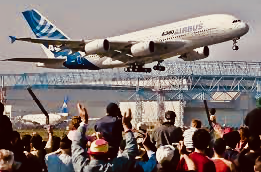
This ‘liner of the skies’ is a four-engined superjumbo with a seating capacity of 550, originally conceived as a counter to Boeing’s long-haul dominating 747 ‘Queen of the Skies’—especially the 747-800. Airbus’s goal: bigger, faster—a mammoth, resplendently spacious double-decker (6,000-square-feet overall), complete with flat-bed suites, full bars and onboard shopping. It afforded all the comfort and luxury of a ‘Floating City’ cruise ship plying the seas, connecting such far-flung mega hubs as New York City, London, Tokyo and Dubai. Early on, A380 passengers loved the extra room, relative quiet and sumptuous features, evoking the past glamour of the supersonic Concorde (even though that revolutionary plane was only ever purchased by two flag carriers, Air France and British Airways).
The A380’s first customer was Singapore Airlines, launching in 2007. Airbus then projected to build (on order) some 1,500 units, 40 per year—becoming the flagship of this new intercontinental jet age. Wherein more and more cities would develop their airport infrastructure as large hubs, with additional and more expansive gates, including gangways for the planes’ upper decks. Airbus was betting ($10b worth) on its A380s threading them together all around the globe. The added beauty being the European consortium was beating its Boeing rival to the Superjumbo punch.
Jumbo Bet vs. Nyet Set.
Trouble was, Airbus’s $10b program soon flew into another $6b in cost overruns and developmental stalls. Then qualms arose over the entire A380 project, as critics posited that the Superjumbo would be too towering, too heavy (weighing in at over one million pounds), and too long for most airports. Skeptics were concerned that its 500+ passengers would swamp customs and immigration checkpoints, baggage handlers would be buried in cargo bin spillage and overloads. The prospect was of further congestion, of increased infrastructure costs due to gate/jetway expansion and tarmac reinforcement for a plane half again as large as the 747 concerned airport officials worldwide—Airbus added landing gear for better weight distribution notwithstanding.
Many potential airline customers began dismissing A380s from the get-go; no American carriers bought the whole Superjumbo concept whatsoever. Even purchasing airlines were concerned about the double-decker’s sheer size, much less the requisite to sell so many of it seats to break even. Singapore, Emirates 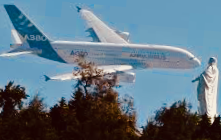 and Qantas did comprise the bulk of A380 tails, however, thus consigning the craft largely to Middle East, Asia and the Pacific routes/service. Meanwhile other carrier execs wrote the jumbo off as pricey white elephant, designed not for the future, but an era that had essentially already passed.
and Qantas did comprise the bulk of A380 tails, however, thus consigning the craft largely to Middle East, Asia and the Pacific routes/service. Meanwhile other carrier execs wrote the jumbo off as pricey white elephant, designed not for the future, but an era that had essentially already passed.
Nevertheless, Airbus pressed ahead with its wager, aiming to blow the Boeing 747’s long-haul dominance out of the skies. Rather than upping that bet, however, Boeing simply changed the game. After considering whether to build a new superjumbo to replace its 747-800, the Chicago-based company decided to fly in a different direction.
For the airline industry, the play would no longer be hub-to-hub, but point-to-point, routing away from those massive A380-geared airports altogether whenever possible. So instead of herding passengers through major hubs in gargantuan aircraft, then ‘spoking’ out to connecting flights bound for ‘secondary’ airports, the future was in direct trips between less crowded points, as swiftly as possible.
This was what more and more lower-cost carriers were now offering, to time-pressed travelers’ growing preference. Such a commercial wind shift called for more flexible, smaller-to-medium-sized aircraft, which Boeing had strategically elected to produce.
Sh-Boom, Sh-Boom, Flight Could Be a Dream.
The plane manufacturer grounded any further 747-800 supersized refinements in favor of an entirely new generation of airliners: the single-aisle, wide-body 787 Dreamliner. These flexible, ultra streamlined mid-sized jets feature such technological advances as strong, lightweight carbon fiber elements and complex computerized (fly-by-wire +) avionics.
But the 787’s other main innovation is its powerful, markedly more efficient engines. Combined with the 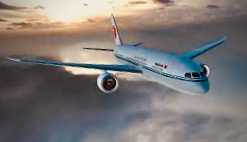 smaller aircraft’s overall lighter components, they enable the plane to fly superjumbo distances on two engines, rather than four—no insignificant factor in today’s volatile jet fuel markets. Little wonder airlines quickly chose the rangy Dreamliner over fuel thirsty A380s and humpback 747s. Suddenly here was a faster, smaller capacity, very long range airplane that was easier to fill passenger wise, and cheaper to fuel and maintain. One that can fly non-stop on many more routes, to many more regional destinations point-to-point (incurring lower landing fees), and safely traversing the Atlantic Ocean, going greener by the aeronautical mile.
smaller aircraft’s overall lighter components, they enable the plane to fly superjumbo distances on two engines, rather than four—no insignificant factor in today’s volatile jet fuel markets. Little wonder airlines quickly chose the rangy Dreamliner over fuel thirsty A380s and humpback 747s. Suddenly here was a faster, smaller capacity, very long range airplane that was easier to fill passenger wise, and cheaper to fuel and maintain. One that can fly non-stop on many more routes, to many more regional destinations point-to-point (incurring lower landing fees), and safely traversing the Atlantic Ocean, going greener by the aeronautical mile.
Over and Out, Jumbo, It’s Been Super.
With Boeing already sunsetting its renowned 747 (save for a strictly cargo role), it was clear as northern skies that Dreamliner was winning out over the long-haul, as airlines highest priority proved to be saving on fuel (roughly one-third of operating costs), rather than speed or supersize. Wasn’t long before A380 customers began to trim back, if not outright cancel their Airbus orders—not least, Qantas, Lufthansa, Virgin Atlantic and Air France-KLM. Singapore ditched their A380s altogether; even state-owned Emirates (which has purchased nearly half of the A380s sold to date) announced that it is cutting its order book from 162 to 123, though will take delivery of some 14 more Superjumbos and fly its 380s through the life of the Airbus program.
Still, all bets were off: there was no saving the A380 longer range. Having delivered but 234 units overall, Airbus concedes the beast has never made a profit in its 13 year run, and the last jumbo will be built in 2021. The consortium’s course change will impact 3k to 350k employee and partner jobs over the next  several years, from Broughton U.K. wings to German nose cones to Spain’s Cadiz and Puerto Real tail sections—not to mention the main Toulouse and Hamburg assembly plants.
several years, from Broughton U.K. wings to German nose cones to Spain’s Cadiz and Puerto Real tail sections—not to mention the main Toulouse and Hamburg assembly plants.
Airbus says in retreat that it will weather the A380’s financial hits, and concentrate on bolstering its healthier, twin-engined A320 narrow body, A330neo mid-size, and A350 wide body (more compact, flexible w/ its own carbon fiber reinforced polymer components). That is, continuing to compete with the likes of Boeing’s mid-range, wide-body 767-200 to 400 (375 capacity) and larger 777-200 to 300 (holding up to 396 passengers).
Gonezilla vs. Trannosoarus X.
![]() The A380’s imminent folding only makes Boeing’s latest counter-move all the more counterintuitive. For its latest entry is a twin-aisle 777-9X, the largest jetliner Boeing has ever attempted. Carrying 400-425 passengers with a range of nearly 8,400 miles, the X is designed for long-haul international routes, cleaner and greener as it goes. It is a replacement for aging 777-
The A380’s imminent folding only makes Boeing’s latest counter-move all the more counterintuitive. For its latest entry is a twin-aisle 777-9X, the largest jetliner Boeing has ever attempted. Carrying 400-425 passengers with a range of nearly 8,400 miles, the X is designed for long-haul international routes, cleaner and greener as it goes. It is a replacement for aging 777-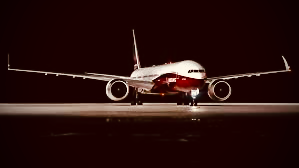 300ERs (396 capacity) and retiring 747s.
300ERs (396 capacity) and retiring 747s.
Over 250 feet tail to nose, it has a 235-foot wingspan, tip to tip—much too wide to fit into most airport gate slots. Hence the 11-foot flaps, hinged to wings’ end on either side. They fold up when this behemoth is on the ground, in effect trimming the span to 212 feet, 8 inches—making the plane a snug shoe-in on most every major concourse.
Powering the new 777 iteration are twin GE-9X’s, the largest jet engines ever built. Each is encased in a nacelle pod measuring 184 inches diameter at its widest point: so large an entire 737 passenger cabin could slip into it.
The planemaker has been building the X in its specialized Everett, WA manufacturing site since 2013. Assembly line robotics and high-pressure ovens are utilized to fashion the 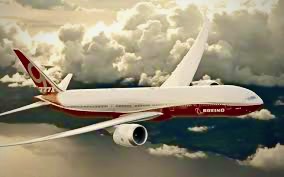 lighter weight carbon-composite wings. A Fuselage Automated Upright Build process then bonds them to a hardened metal fuselage, engines and all. When the FAUB robotics faltered last November and fuselage stress cracks developed, union machinists handily completed fit and finish on the largest jetliner now flown worldwide. So, X-haltation at last? It all hinges on whether the “flapper” can safely, surely spread its massive revamped wings like never before.
lighter weight carbon-composite wings. A Fuselage Automated Upright Build process then bonds them to a hardened metal fuselage, engines and all. When the FAUB robotics faltered last November and fuselage stress cracks developed, union machinists handily completed fit and finish on the largest jetliner now flown worldwide. So, X-haltation at last? It all hinges on whether the “flapper” can safely, surely spread its massive revamped wings like never before.
Still, between a recent successful initial test flight and ultimate airworthiness certification will come intense FAA scrutiny—an exactingly thorough, rather than a compressed flight test regimen, in the wake of Boeing’s MAX/MCAS fiasco.
The planned 9X rollout has already logged 358 orders, many from British Airways’ IAG 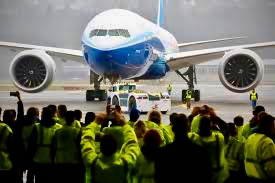 parent—even while the 777X sales pace has otherwise been slackening lately in a comparatively smaller ‘big plane’ market.
parent—even while the 777X sales pace has otherwise been slackening lately in a comparatively smaller ‘big plane’ market.
Downsliding as well are airline orders for most all twin-aisled jets (sales or lease/rentals), in the face of slower passenger growth. Boeing is cutting 787 and 777-8 production from 14 to 12 in 2020; Airbus is trimming A350 output to 10 per month. Major buyers from Qatar and Etihad Airways are looking to delay or off load their 777X and 787 Dreamliner orders amid increasing competition and a trend toward instead keeping/ refurbishing existing ‘big jet’ fleets, to expand capacity.
Further, Emirates Airlines is tapping brakes on its order for 30 long-delayed Boeing 777X ‘big jets’, in favor of 30 smaller 787 Dreamliners, with an $8.8b price tag ($3.8b less than for its original 777X order)—if not moving toward a $16b deal for rival Airbus A350-900s. Beyond that, Air China’s wide-body appetite is also stanched by U.S.-China trade tensions and weaker demand.
Nevertheless, it appears the dinosaur evolution continues over the long haul, after all.
Meanwhile, on a smaller, more regional scale, Boeing will also be introducing a mid-market 797 in the 2020s—a twin-engined, dual-aisle wide-body model with either Pratt & Whitney turbofan or GE/CFM LEAP engines, to carry 225-275 with a 5,000 mile range. Airbus A320 and 330neo—a 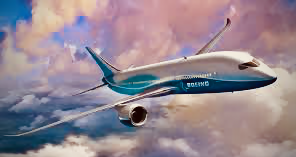 consortium line may soon be joined by a twin-aisle A350-1000 stretched to 400 capacity, as if its A380 Superjumbo never faded to extinction in the first place.
consortium line may soon be joined by a twin-aisle A350-1000 stretched to 400 capacity, as if its A380 Superjumbo never faded to extinction in the first place.
So time and Vamigré will tell which behemoth wins the next-generation battle of the skies…
